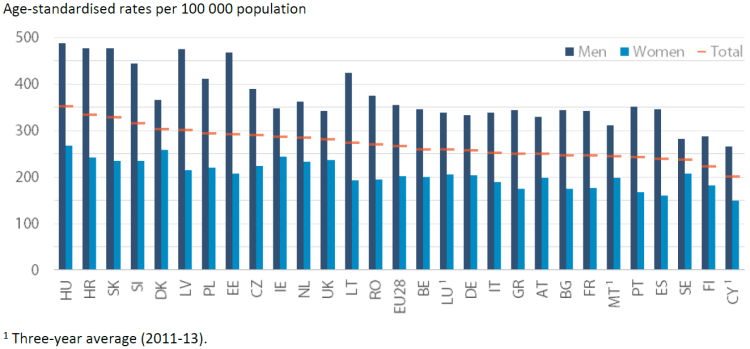Written by Nicole Scholz,
World Cancer Day is a global awareness-raising initiative of the Union for International Cancer Control (UICC), supported by the World Health Organization (WHO) and the International Agency for Research on Cancer (IARC). The initiative aims to spread the word about cancer and prod governments and individuals into action, with a view to potentially saving millions of lives.
The theme for the World Cancer Day series 2016-2018 is ‘We can. I can.’ The day is dedicated to exploring how everyone can do their part to reduce the impact that cancer has on individuals, families and communities. Actions World Cancer Day should inspire include:

Data source: World Cancer Day 2014-2018, key messages.
Activities for World Cancer Day 2017 are planned all over the world (see the interactive map), including the ‘talking hands’ campaign on social media, at #WorldCancerDay and #WecanIcan.

Background: cancer in Europe
Cancer refers to a group of diseases characterised by uncontrolled growth of abnormal cells that can invade adjoining parts of the body and spread to other organs (forming metastases). Cancer can affect any part of the body – there are more than 100 types of cancer. In 2013, cancer was the second most common cause of death in the EU. More than 1.3 million people died from cancer that year across the 28 Member States, the main causes being lung, colorectal and prostate cancer among men, and breast, lung, and colorectal cancer among women. The main risk factors for cancer are smoking and drinking, an unbalanced diet (especially one low in fruit and vegetables), excess weight, lack of physical activity, as well as environmental and work-related exposure to cancer-causing substances (carcinogens). Over 30 % of cancer deaths are preventable, mainly through avoiding risk factors and adopting a healthy lifestyle. Today, with early detection (notably screening programmes) and adequate treatment, many cancers are curable.
Cancer mortality rates in Europe, 2013

Data source: Eurostat Database; graph adapted from Health at a Glance: Europe 2016, OECD.
What is the EU doing to help fight cancer?
The EU can complement and add value to Member States’ efforts by encouraging the sharing of information and know-how, and by fostering cooperation. The European Commission takes action in areas such as prevention, screening, quality assurance and research. For instance, in 2009, it established the European Partnership for Action Against Cancer (EPAAC) joint action (2009-2013). The 2014 report on implementation of the partnership found that EU action has strengthened cooperation and created added value. Building on the EPAAC, the Comprehensive Cancer Control (Cancon) joint action 2014-2017 aims to help reduce the cancer burden in the EU. Its main deliverable, a European guide on quality improvement in cancer control, will be presented at the joint action’s final conference in Malta on 14-15 February 2017.
The European code against cancer, developed in cooperation with the WHO and IARC, is a set of 12 recommendations on ways in which people can reduce their cancer risk. Its fourth edition was launched in 2014.
In line with the 2003 Council recommendation on cancer screening, the Commission has produced several guidelines to support Member States in implementing screening programmes. The first four screening recommendations under the recent European Commission initiative on breast cancer (ECIBC) were launched in November 2016 – in total, some 90 are to be developed over the next few years. The need to implement nationwide mammography screening was also underlined in European Parliament resolutions of 2003 and 2006, and in a 2015 written declaration.
The EU is also funding cancer research projects under its framework programme for research and innovation, Horizon 2020 (2014-2020).
Other relevant EU action includes addressing risk factors through legislation. An example is the Commission’s current proposal to amend the Carcinogens and Mutagens Directive in successive steps, by expanding its scope and by including and/or revising occupational exposure limit values for a number of cancer-causing chemical agents. The rapporteur for the European Parliament’s Committee on Employment and Social Affairs (EMPL), Marita Ulvskog (S&D, Sweden), published her draft report on 29 November 2016. A Committee vote is scheduled for 27-28 February 2017.
EPRS publications on the topic
EPRS At-a-glance note: Can processed and red meat cause cancer?, October 2015.
EPRS At-a-glance note: European Union action on cancer, February 2017.
EPRS Implementation Appraisal: Exposure to carcinogens and mutagens at work, June 2016.
EPRS Initial Appraisal of the Commission Impact Assessment: Protection of workers from exposure to carcinogens or mutagens, July 2016.
EPRS ‘Legislation in progress’ briefing: Limits on exposure to carcinogens and mutagens at work, February 2017.
Further reading
European Commission, factsheets on cancer in Europe, published by the Joint Research Centre (JRC) and the European Network of Cancer Registries (ENCR): Thyroid cancer, January 2017; Bladder cancer, November 2016; Pancreatic cancer, October 2016; Cervical cancer, March 2016; Melanoma, April 2015; Breast cancer, September 2014; Lung cancer, June 2014; Prostate cancer, March 2014; Colorectal cancer, December 2013.
European Parliament, Policy Department A studies for the ENVI committee: Data saves lives: The impact of the Data Protection Regulation on personal data use in cancer research, January 2016; and The fight against cancer is a team sport: The role of education and sport, December 2016.







